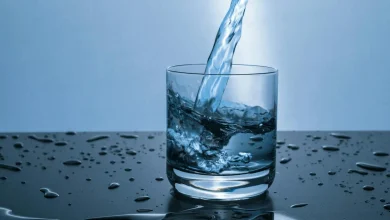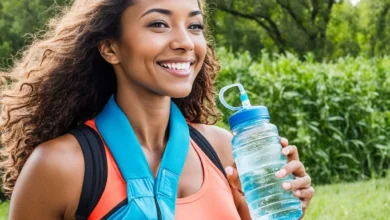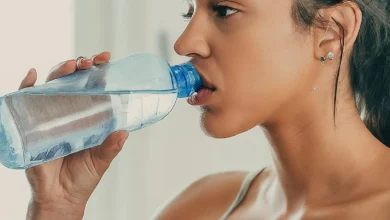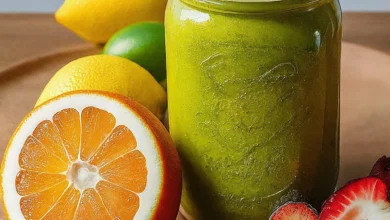Stay Hydrated on Long Flights: Essential Tips for Travelers

Introduction
Staying Hydrated in the Skies
Did you know that a 3-hour flight can drain up to 1.5 liters of water from your body? That’s a whopping 8% of your total body water! This eye-opening fact underscores why hydration is crucial during air travel, especially on long flights.
Why Hydration Matters
As you soar through the clouds, your body faces unique challenges:
- High altitudes
- Low cabin humidity
- Limited access to drinks
These factors can leave you feeling:
- Parched
- Tired
- More prone to jet lag
What You’ll Learn
Don’t worry – we’ve got you covered! In this post, you’ll discover:
- Effective hydration strategies
- Tips for before, during, and after your flight
- Ways to feel your best from takeoff to landing
Let’s dive in and explore how to keep your body happy and hydrated on your next long-distance journey!
Why Hydration Matters on Long Flights
The Sky-High Challenge
Flying isn’t just about getting from point A to point B. It’s also a unique environment for your body. Let’s break down why staying hydrated is so important when you’re up in the air:
1. Altitude Effects
When you’re cruising at 30,000 feet, your body reacts in several ways:
- Faster breathing: The lower air pressure makes you breathe more quickly.
- Increased urination: Your body releases more water as you adjust to the altitude.
- Drier air: The air inside the plane is much drier than what you’re used to on the ground.
2. Cabin Conditions
Airplane cabins are designed for safety, but not necessarily for comfort. Here’s what you’re dealing with:
- Low humidity: Typically, cabin air has only 10-20% humidity. Compare that to the 30-60% you’re used to at home!
- Recycled air: The constant circulation of dry air can speed up moisture loss from your skin and lungs.
3. Health Risks of In-Flight Dehydration
Failing to drink enough water during your flight can lead to several uncomfortable symptoms:
- Fatigue: You might feel more tired than usual.
- Headaches: Dehydration is a common trigger for headaches.
- Dry skin: Your skin might feel tight, itchy, or flaky.
- Increased jet lag: Dehydration can make it harder for your body to adjust to a new time zone.
Why It Matters
Staying hydrated isn’t just about comfort – it’s about protecting your health. Proper hydration helps your body:
- Regulate temperature
- Keep joints lubricated
- Deliver nutrients to cells
- Maintain organ function
By understanding these challenges, you can take proactive steps to stay hydrated and feel your best during and after your flight.
Pre-Flight Hydration Strategies
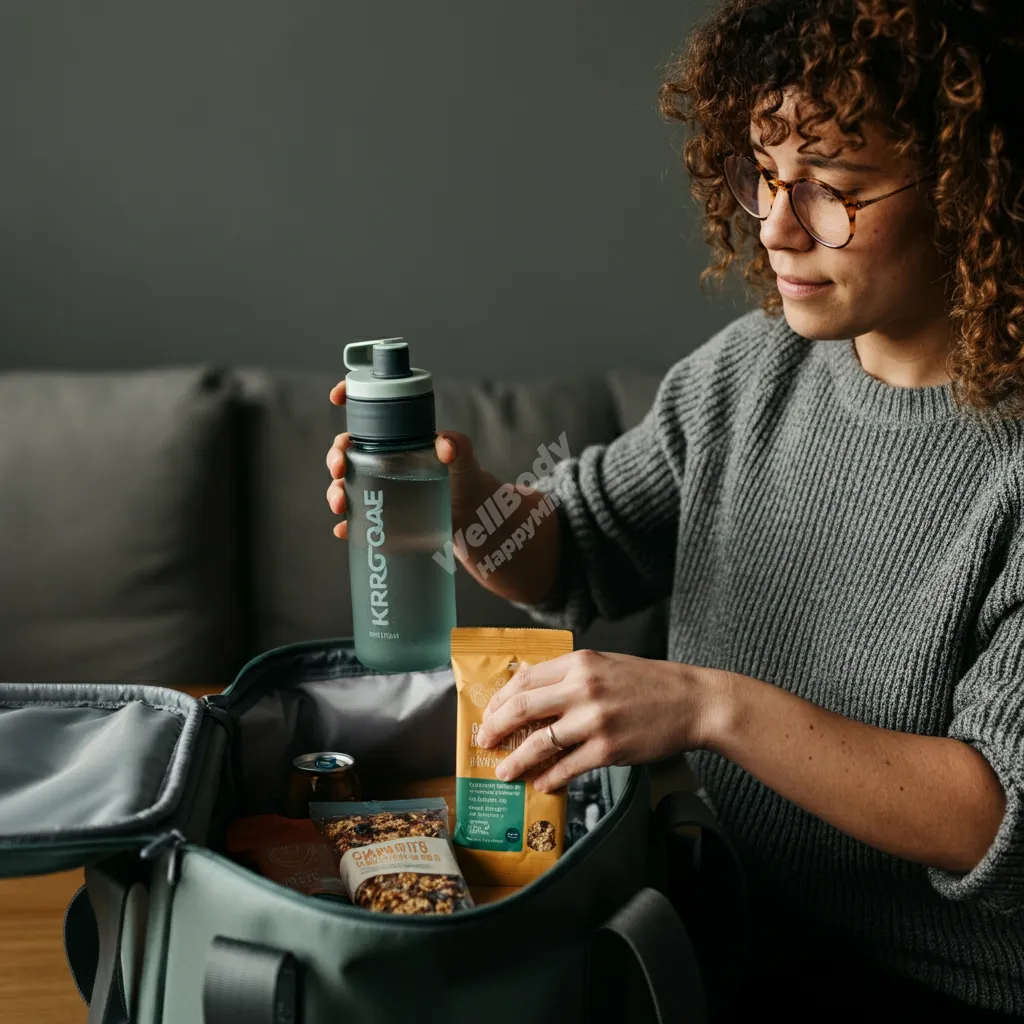
Setting the Stage for a Hydrated Journey
What you do before you board can make a big difference in how you feel during your flight. Let’s explore some smart pre-flight hydration tactics:
A. Hydrate Early and Often
Start boosting your water intake 2-3 days before your flight. This gives your body a head start and helps build up your hydration reserves.
Pro tip: Aim to drink an extra glass of water with each meal in the days leading up to your trip.
B. Choose Your Pre-Flight Drinks Wisely
Not all beverages are created equal when it comes to pre-flight hydration. Here’s a quick guide:
| Recommended | Discouraged |
|---|---|
| Water | Alcohol |
| Coconut water | Caffeinated drinks |
| Herbal tea | Sugary sodas |
| Diluted fruit juices | Energy drinks |
Why avoid alcohol and caffeine? These can act as diuretics, making you lose more water through increased urination.
C. Hydrating Foods to Pack
Sneak in extra hydration with water-rich foods. These tasty options can help:
- Cucumber slices
- Watermelon cubes
- Cherry tomatoes
- Celery sticks
- Apple slices
Bonus tip: Pack these in a small, clear container for an easy-to-carry, TSA-friendly snack.
D. The Airport Hydration Hack
Once you’ve passed security, make a beeline for a water fountain or shop. Buy or fill a large water bottle to carry onto the plane. This ensures you’ll have water available even before the in-flight service begins.
E. Moisturize Your Skin
While not directly related to internal hydration, applying a good moisturizer before your flight can help prevent your skin from drying out in the low-humidity cabin environment.
By following these pre-flight strategies, you’ll board your long-distance flight well-hydrated and prepared to tackle the challenges ahead. Remember, when it comes to flying, preparation is key to comfort!
In-Flight Hydration Tips

Staying Hydrated at 30,000 Feet
Now that you’re on the plane, let’s explore how to maintain your hydration throughout the flight.
A. How Much Water Should You Drink?
The million-dollar question: just how much water do you need? While individual needs vary, here’s a simple guideline:
Hydration Formula: Drink 8 ounces (240 ml) of water for every hour of flight time.
For example:
- 8-hour flight = 64 ounces (1.9 liters)
- 12-hour flight = 96 ounces (2.8 liters)
Remember, this is a general guide. Listen to your body and drink when you feel thirsty.
B. Best Times to Hydrate During the Flight
- Right after takeoff: Once the seatbelt sign is off, have your first drink.
- With meals: Always accept water when the meal service comes around.
- Every hour: Set a quiet alarm on your phone as a reminder.
- Before sleep: Have a small amount of water before napping.
- Upon waking: Rehydrate after any sleep, even short naps.
Pro tip: Avoid drinking large amounts right before expected turbulence or shortly before landing.
C. Alternatives to Plain Water
While water is the gold standard, you can mix things up with these hydrating options:
- Herbal teas: Caffeine-free and soothing. Try chamomile or peppermint.
- Coconut water: Packed with electrolytes for extra hydration.
- Electrolyte drinks: Great for long flights, but watch the sugar content.
- Low-sodium tomato juice: A savory option often available on flights.
D. Hydration Boosters
- Avoid the salty snacks: They can increase thirst and bloating.
- Use a hydrating face mist: Refreshes your skin and reminds you to drink.
- Eat fresh fruit when available: It adds to your fluid intake.
E. Overcoming Hydration Hurdles
- Limited beverage service: Politely ask flight attendants for extra water when they pass by.
- Sleeping through drink service: Keep a small water bottle at your seat.
- Avoiding too many bathroom trips: Sip regularly rather than gulping large amounts at once.
Remember, staying hydrated on a long flight takes a bit of planning and effort, but your body will thank you upon landing. Keep sipping, and you’ll arrive at your destination feeling more refreshed and ready to go!
Overcoming Hydration Obstacles

Navigating the Challenges of In-Flight Hydration
Staying hydrated during a long flight isn’t always smooth sailing. Let’s tackle some common obstacles and how to overcome them.
A. Dealing with Limited Beverage Service
Flight attendants can’t always be at your beck and call, so here’s how to manage:
- BYO Water Bottle: Bring an empty reusable bottle through security and fill it up before boarding.
- Befriend the Galley: Politely ask flight attendants if you can refill your bottle between service rounds.
- Stock Up: When drinks are offered, ask for an extra cup of water to keep at your seat.
Pro tip: Choose an aisle seat for easier access to water and restrooms.
B. Navigating Bathroom Trips Politely
Frequent hydration means more trips to the lavatory. Here’s how to handle it gracefully:
- Time it Right: Try to use the restroom during natural breaks (meal times, when seatbelt sign is off).
- Be Considerate: If your seatmates are sleeping, consider using lavatories further back or in a different cabin.
- Quick and Efficient: Have everything you need ready before you get up to minimize disturbance.
C. Balancing Hydration with Sleep
It’s tricky to stay hydrated without disrupting your rest. Try these strategies:
- Front-load Your Hydration: Drink more water during the early part of the flight.
- Taper Off: Reduce intake 1-2 hours before you plan to sleep, but don’t stop completely.
- Small Sips: Keep a small water bottle at your seat for occasional sips during the night.
- Hydrate Upon Waking: Have a good drink of water when you wake up, even from short naps.
D. Dealing with Dry Air
The low humidity in planes can dry you out quickly. Combat this by:
- Using a Nasal Spray: Keeps your nasal passages moist and comfortable.
- Applying Lip Balm: Prevents chapped lips.
- Moisturizing Regularly: Bring a travel-sized lotion for hands and face.
E. Overcoming the Temptation of Free Alcohol
While tempting, alcohol can severely dehydrate you. If you choose to indulge:
- Match Each Drink: Have a full glass of water for every alcoholic beverage.
- Limit Yourself: One drink max for every 3-4 hours of flight time.
- Timing Matters: Avoid alcohol close to bedtime or immediately after takeoff.
Remember, overcoming these obstacles is key to arriving at your destination feeling refreshed and ready to go. With a little planning and these strategies in your toolkit, you can stay comfortably hydrated throughout your journey.
Post-Flight Recovery

Landing Hydrated: Your Arrival Game Plan
You’ve made it through the flight, but your hydration journey isn’t over yet. Let’s explore how to recover and rehydrate once you’ve landed.
A. Rehydrating After Landing
- First Things First: Drink a glass of water as soon as you can after landing.
- Gradual Intake: Continue sipping water regularly over the next few hours. Don’t try to make up for lost fluids all at once.
- Electrolyte Boost: Consider an electrolyte drink to replenish minerals lost during the flight.
Pro tip: Keep a reusable water bottle handy and refill it at the airport before heading to your destination.
B. Signs of Dehydration to Watch For
Even if you’ve been diligent, you might still be dehydrated. Look out for these symptoms:
- Dark urine: Should be pale yellow, not dark amber.
- Dry mouth or lips
- Feeling dizzy or lightheaded
- Unusual fatigue
- Headache
If you notice these signs, increase your fluid intake gradually and rest if possible.
C. Tips for Getting Back on Track
Eat Water-Rich Foods:
- Fresh fruits (watermelon, oranges, grapes)
- Crisp vegetables (cucumbers, celery, bell peppers)
- Light soups or broths
Avoid Dehydrating Substances:
- Limit caffeine and alcohol for the first few hours after landing.
- If you do indulge, match each dehydrating drink with an extra glass of water.
Moisturize Your Skin:
- Apply lotion to combat the drying effects of the flight.
- Use a facial mist for quick refreshment.
Move Your Body:
- Light exercise like walking can help stimulate circulation and reduce fluid retention.
- Just remember to drink water before, during, and after any physical activity.
Sleep Smart:
- Keep a glass of water by your bed, especially if you’re dealing with jet lag.
- Take small sips if you wake up during the night.
D. Adjusting to a New Climate
If you’ve landed in a different climate, be aware that your hydration needs might change:
- Hot Destinations: You’ll likely need to drink more water than usual.
- Cold Destinations: Don’t forget to hydrate, even if you don’t feel as thirsty.
- High Altitude Locations: Increase your water intake to help with altitude adjustment.
Remember, proper post-flight hydration can help minimize jet lag, boost your energy, and get your trip off to a great start. Listen to your body, drink up, and enjoy your destination!
Tools and Accessories for Better In-Flight Hydration

Gear Up for Hydration Success
The right tools can make staying hydrated during your flight much easier. Let’s explore some useful accessories to keep you well-watered at 30,000 feet.
A. Reusable Water Bottles and Collapsible Cups
Insulated Water Bottles:
- Keep drinks cold (or hot) for hours
- Look for vacuum-sealed, stainless steel options
- Recommended: Hydro Flask or S’well bottles
Collapsible Water Bottles:
- Save space when empty
- Lightweight and easy to pack
- Try: Vapur or Platypus brands
Foldable Cups:
- Perfect for small sips without disturbing seatmates
- Easily stowed in seat pocket
- Consider: Stojo collapsible cup
Pro tip: Choose bottles with wide mouths for easy cleaning and filling.
B. Electrolyte Tablets or Powders
These can help replace minerals lost during flight and enhance hydration:
- Nuun Tablets: Drop in water for a fizzy, flavored drink
- Liquid I.V. Packets: Powder mix with rapid absorption technology
- DripDrop ORS: Medical-grade rehydration formula
Remember: Always read instructions for proper dosage.
C. Hydration-Tracking Apps
Keep yourself accountable with these smart hydration helpers:
WaterMinder:
- Sets personalized goals based on your body
- Sends reminders throughout the day
- Syncs with Apple Health
Hydro Coach:
- Calculates fluid needs based on various factors
- Offers detailed statistics and graphs
- Available for Android devices
Plant Nanny:
- Makes hydration fun with virtual plant care
- Grow cute plants as you meet water goals
- Great for making hydration a habit
D. Additional Hydration Helpers
Facial Mist Sprays:
- Refresh skin and remind you to drink
- Look for options with added minerals
Humidifying Face Masks:
- Add moisture to the air you breathe
- Can double as a sleep mask
Electrolyte-Infused Chewing Gum:
- Stimulates saliva production
- Helps combat dry mouth
E. Choosing the Right Gear
When selecting hydration tools, consider:
- TSA Compliance: Ensure bottles are empty before security
- Durability: Choose products that can withstand travel wear and tear
- Size: Balance capacity with portability
- Ease of Cleaning: Opt for dishwasher-safe items when possible
Remember, the best hydration tool is the one you’ll actually use. Choose items that fit your travel style and preferences to make staying hydrated a breeze.
Special Considerations

Tailoring Your Hydration Strategy
While general hydration tips apply to most travelers, certain groups may need to pay extra attention to their fluid intake. Let’s explore some special considerations for different travelers.
A. Hydration Needs for Different Age Groups
Children:
- Need more frequent hydration reminders
- Offer small, regular sips to avoid overfull bladders
- Pack fun, colorful water bottles to encourage drinking
Older Adults:
- May have a reduced sense of thirst
- Often more susceptible to dehydration
- Should drink water even when not feeling thirsty
Pregnant Women:
- Require extra hydration due to increased blood volume
- Should aim for at least 8-10 cups of water daily
- May need more frequent bathroom breaks
B. Managing Hydration with Certain Health Conditions
Diabetes:
- Dehydration can affect blood sugar levels
- More frequent blood glucose monitoring may be necessary
- Pack sugar-free electrolyte drinks
Heart or Kidney Issues:
- May have fluid intake restrictions
- Consult with a doctor before travel for personalized advice
- Consider bringing a small measuring cup for precise intake
Motion Sickness:
- Small, frequent sips may be easier to tolerate
- Ginger tea can help with nausea while providing hydration
C. Alcohol and Caffeine Consumption During Flights
While it’s best to avoid these during flights, if you do indulge:
Alcohol:
- Limit to one drink per 3-4 hours of flight time
- Follow each alcoholic beverage with a full glass of water
- Be aware that alcohol’s effects can be stronger at altitude
Caffeine:
- Moderate consumption (1-2 cups) is generally okay
- Avoid caffeinated drinks close to bedtime, especially on overnight flights
- Balance with extra water intake
D. Medications and Hydration
Some medications can affect hydration needs:
- Diuretics: May increase fluid loss; consult your doctor about adjusting dosage for travel
- Antihistamines: Can cause dry mouth; increase water intake accordingly
- Blood Pressure Medications: May require careful fluid balance; discuss with your healthcare provider
E. Hydration for Ultra-Long Haul Flights
For flights exceeding 12 hours:
- Set hourly hydration reminders
- Alternate between water and electrolyte drinks
- Consider using a humidifying face mask during sleep periods
Remember, these are general guidelines. For specific health concerns, always consult with a healthcare professional before your trip. Tailoring your hydration strategy to your individual needs will help ensure a comfortable and healthy long-distance flight experience.
Conclusion
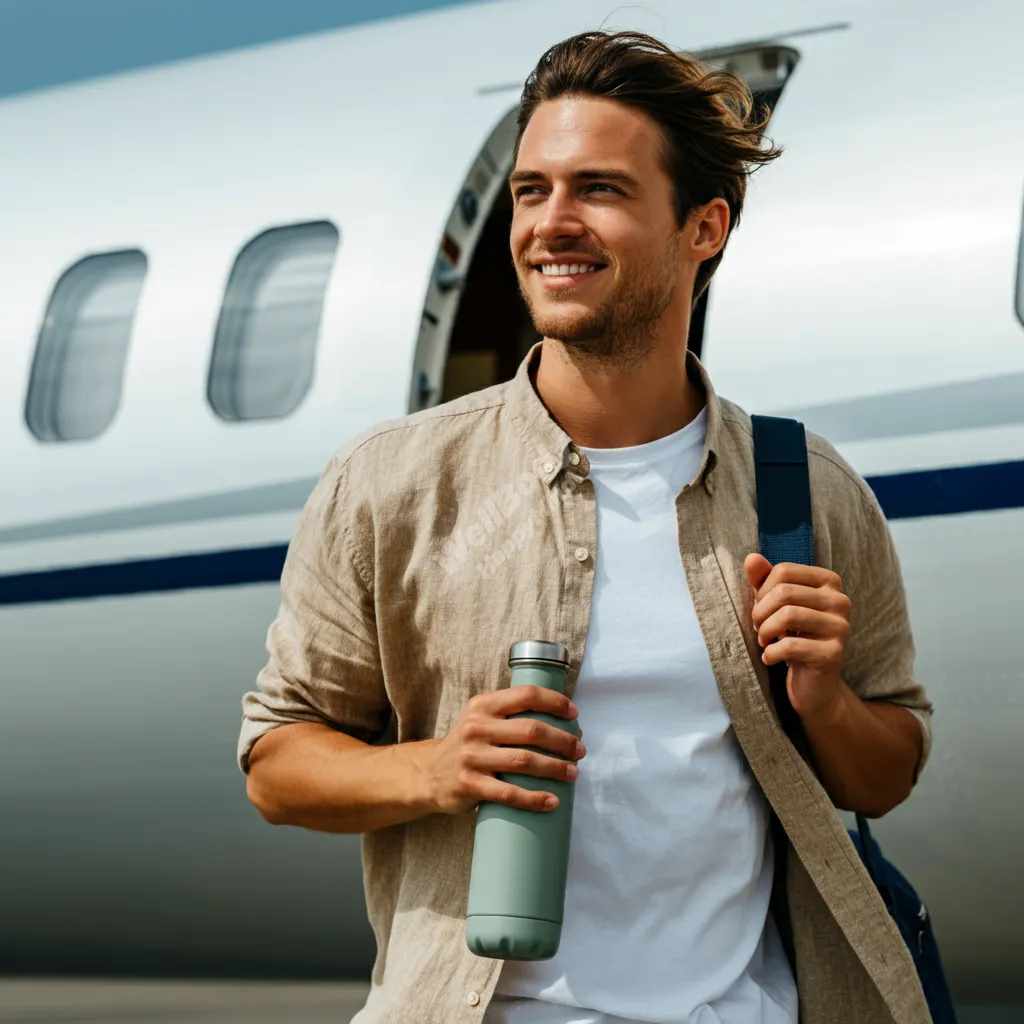
Staying Hydrated for a Better Travel Experience
As we wrap up our journey through in-flight hydration, let’s recap the key strategies for staying well-watered during your long-distance flights:
1. Pre-Flight Preparation:
- Start hydrating 2-3 days before your flight
- Choose water-rich foods and hydrating beverages
- Pack an empty water bottle to fill after security
2. In-Flight Hydration:
- Aim for 8 ounces of water per hour of flight time
- Set reminders to drink regularly
- Opt for hydrating beverages over alcohol and caffeine
3. Overcoming Obstacles:
- Plan for limited beverage service
- Balance hydration with sleep and bathroom trips
- Combat dry air with moisturizers and nasal sprays
4. Post-Flight Recovery:
- Rehydrate gradually after landing
- Watch for signs of dehydration
- Adjust your intake based on your destination’s climate
5. Tools for Success:
- Invest in a good reusable water bottle
- Consider electrolyte supplements for longer flights
- Use hydration-tracking apps to stay on course
6. Special Considerations:
- Tailor your hydration strategy to your age and health needs
- Be mindful of how medications might affect your hydration
Why It All Matters
Proper hydration isn’t just about avoiding thirst. It’s about:
- Reducing jet lag symptoms
- Maintaining energy levels
- Supporting your immune system
- Enhancing overall comfort during and after your flight
By prioritizing hydration, you’re setting yourself up for a more enjoyable travel experience. You’ll likely feel more alert, less fatigued, and better prepared to dive into your destination activities upon arrival.
Your Hydration Action Plan
- Before your next flight: Gather your hydration tools (water bottle, electrolytes, etc.)
- During booking: Consider seat selection for easy aisle access
- Day of travel: Start your journey well-hydrated and prepared
Remember, staying hydrated on long-distance flights is a simple yet powerful way to take control of your travel wellness. With these strategies in your toolkit, you’re ready to fly comfortably and arrive at your destination feeling your best.
Safe travels and happy hydrating!
